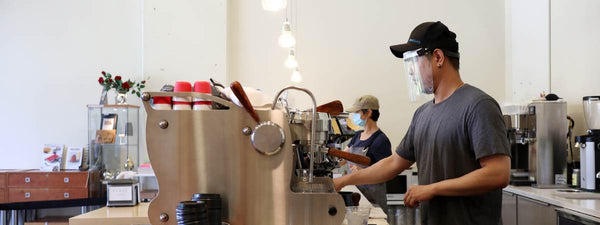
Enjoying Coffee While Going Back To Work
HOW HAS COVID-19 AFFECTED COFFEE SHOPS?
For many of us, visiting a coffee shop near the office is a daily ritual. However, because of the pandemic, many businesses across the world have had to close their doors, including coffee shops. In June 2020, only 41% of small businesses were fully open in the US. To date, around 20% remain completely closed.
Jieun Kim is a barista at KAHVE in Vancouver BC, Canada. She explains how the café has been affected by the pandemic:
“KAHVE had to close in March. In mid-May, the store reopened after the British Columbia Ministry of Health announced new health and safety policies for the food service business, including maximum seating capacity.”
Guidelines are still changing with Covid-19 infection rates, and they can be difficult to follow. It’s imperative that coffee shop owners keep track of any changes that could affect their businesses.
Over the course of April, as many as one in five people across the world were instructed to stay at home. However, while many cafés closed, others adapted to offer coffee in a different way. For example, some changed to offer coffee and brewing equipment online, while others started providing pickup and delivery options.
Mat North is the founder and co-owner of Full Court Press in Bristol, UK. Since stopping indoor service on March 21, Full Court Press have started offering delivery by bicycle for customers.
Mat says that hygiene and safety have been priorities when he delivers coffee. He tells me: “For bike deliveries, gloves are useless unless you change each time you use them. I take some hand sanitiser with me, place [the] delivery on the step, and retreat where possible.”
Around 26% of coffee shops were fully cashless by the end of April, and this number is only set to increase as the pandemic pushes more people to move away from cash. However, Mat has designed a way for his baristas to accept cash and minimise the spread of the virus.
“Cash is a crucial system,” Mat believes. “There is no significant danger to taking cash if managed properly. To help [with] this, we use a UV sanitiser and tip trays.”
However, despite the fact that cafés are reopening, sitting in for an extended period of time isn’t really an option in many areas. Working, studying, or even having a meeting in a coffee shop is not currently feasible for most people. How we consume coffee has drastically changed, and it looks like it will still be a while before things are back to normal.
“Coffee shops won’t be a place for study and work until the pandemic is gone,” Jieun says.

RETURNING TO COFFEE SHOPS SAFELY
So, how do we adapt? Well, more and more businesses are reopening every day, meaning that you might be considering a return to your favourite coffee shop. Before you go back, however, make sure that you are fully aware of the new health and safety guidelines in place.
Jieun tells me about the protective measures used at KAHVE. “To protect staff, [we] provided masks and face protectors, [and] installed a glass shield at the till to avoid direct contact with customers.” She also notes that the coffee shop has “removed the complimentary area” and now “provides milk, water, etc upon request”.
Using personal protective equipment (PPE) like masks and face shields is crucial in preventing the spread of Covid-19. However, it’s important to remember that PPE is most effective when everyone uses it. Where necessary, remember to wear a mask inside a coffee shop. If you’re not sure whether or not you need one, keep a mask on your person just in case.
Remember that most coffee shops will also be operating at limited capacity. This means longer queues, so make sure that you arrive with plenty of time to spare, or wait until after the morning rush. Some coffee shops may offer hand sanitiser and disinfectant wipes if you don’t come with your own.
It’s also important to be mindful of the fact that procedures will change from café to café. Mat explains that Full Court Press have set up a socially distanced espresso bar that is comfortable for both customers and staff.
“The key for us was to create a space that customers would feel safe and welcome in. We did this by creating space between the customers and staff, using an atypical bar design. All interactions are at an angle, which extends the distance between staff and customers.”
RESPONSIBLY ENJOYING COFFEE IN THE OFFICE
For those who prefer to avoid cafés, brewing and drinking coffee in the office is still an option. However, as you go back to work, be aware that there will likely be a lot of changes in your office building. For example, many workplaces have now banned shared coffee pots entirely.

Where possible, drinkers need to consider responsible consumption options. Alan Adler is the president of AeroPress Inc. and the inventor of the original AeroPress coffee maker. He tells me about the new AeroPress Go travel coffee press, which is a self-contained brewing device that comes with its own mug and lid.
“It has a mug that the AeroPress fits inside of, along with a scoop, and you can even squeeze a little bit of coffee in there for a day’s use. It would allow you to keep your consumption germ-free, away from the usual office pot.”
As the AeroPress Go packs up in its own mug, the consumer can easily transport it from home to office without losing any of the brewing equipment. The AeroPress Go’s included mug also means that you don’t have to risk sharing mugs with your co-workers.
Most people would naturally be concerned that making coffee at your desk could get messy. However, Alan explains that the AeroPress Go is designed to prevent spillages.
“The process is very tidy: you put 1 or 2 scoops of grounds into the AeroPress Go, and the scoop means that they all go inside and don’t spill.”
“After you press it, you eject the grounds into the trash then you can just leave it alone. If you want, you could rinse it off, or simply wipe the seal with a tissue or paper towel.”
“It makes a very sweet and rich cup. You can enjoy it at room temperature, or warm it after brewing in the office microwave.”
For consumers who prefer to brew coffee at work, Jieun says that the “most important thing” is “using good beans”. She recommends that people “ask a barista for advice on which beans to buy, and if possible, invest in a grinder”.

It doesn’t matter whether you’re enjoying coffee at a café near your workplace, or brewing in the office. The most important thing is staying up to date on the health and safety procedures that are designed to protect you and those around you.
However, as you go back to work, consider which option is most convenient and comfortable for you. Brewing at your desk might not have been something you would have considered before Covid-19, but who knows – it might even become your new favourite hobby.

